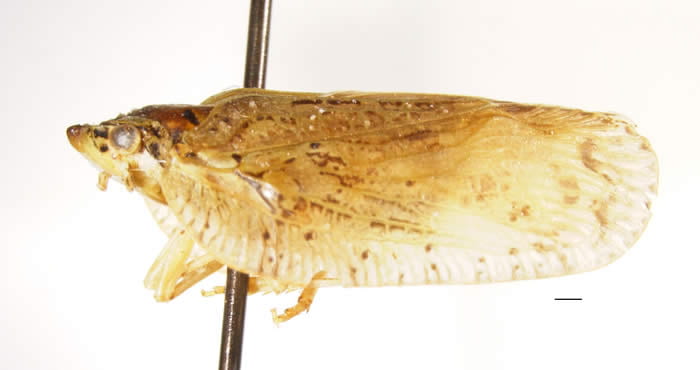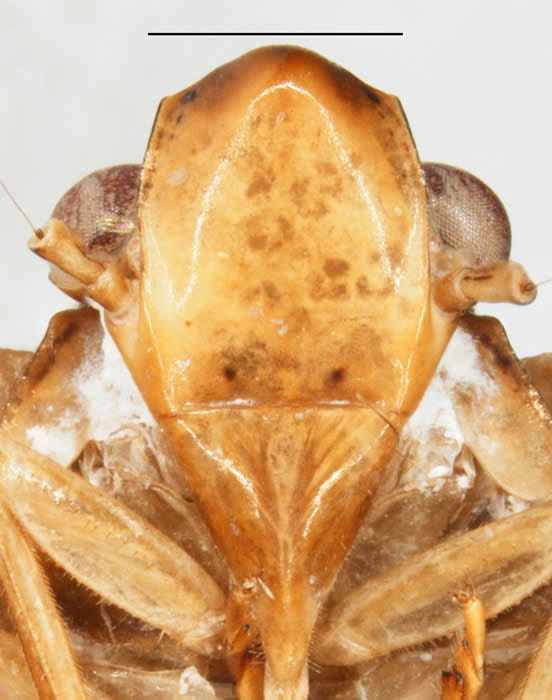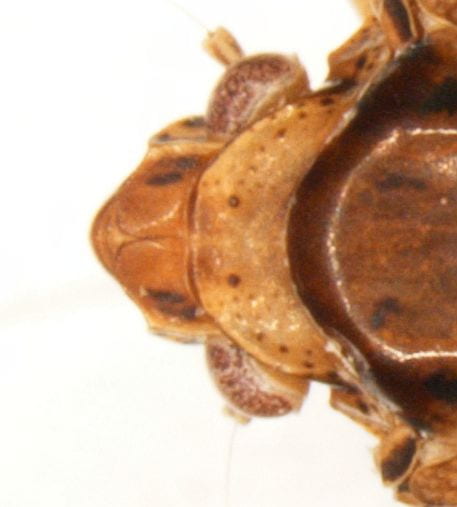[Back to North American Flatidae]
Contents
- 1 Family Flatidae Spinola, 1839
- 1.0.1 Subfamily Flatoidinae Melichar, 1901
- 1.0.2 Tribe Flatoidini Melichar, 1901
- 1.0.3 Genus Flatoidinus Melichar, 1923: 117
Family Flatidae Spinola, 1839
Subfamily Flatoidinae Melichar, 1901
Tribe Flatoidini Melichar, 1901
Genus Flatoidinus Melichar, 1923: 117
Type species (in original combination): Poeciloptera conviva Stål, 1862
Synonyms
none.
Distribution
Mostly Caribbean and central American (also southeastern US).
Recognized species
There are 23 species currently assigned to this genus:
(Synonyms and links will be added later.)
- Flatoidinus acuta (Uhler, 1901) – Jamaica, Haiti, Dominican Republic, Cuba, Isle of Pines, Puerto Rico, Bahamas, South Bimini Island, USA: FL, GA (US records may be in error) = Dascalia acuta Uhler, 1901: 515. = Flatoides acuta (Uhler, 1901); comb. by Van Duzee 1909: 193. = Flatoides acutus (Uhler, 1901); emendation by Van Duzee 1917b: 756. = Flatoidinus acutus var. acutus (Uhler, 1901); comb. and status by implication Metcalf & Bruner 1948: 115.
- Flatoidinus acutus bipunctatus (Metcalf & Bruner, 1948) – Cuba = Flatoidinus acutus humeralis (Metcalf & Bruner, 1948) – Cuba = Flatoidinus acutus maculosus (Metcalf, 1923) (Cuba, USA: Florida) – see F. punctatus
- Flatoidinus bifidus Caldwell & Martorell, 1951 – Puerto Rico
- Flatoidinus caesalpiniae Fennah, 1965 – Montserrat = Flatoidinus caesalpiniae nevisanus Fennah, 1965 – Nevis
- Flatoidinus calliger (Gerstaecker, 1895) – Brazil (Santa Catarina)
- Flatoidinus convivus (Stål, 1862) – Brazil (Rio de Janeiro)
= Poeciloptera conviva Stål, 1862: 13.
= Flatoidinus convivus (Stål, 1862), comb. by Melichar (1923: 117).
= Dascalia conviva Stål, 1862 syn. by Metcalf (1957).
= Flatoides convivus Stål, 1862 comb. by Metcalf (1957). - Flatoidinus cordiae Fennah, 1945 – Trinidad
- Flatoidinus dorsisigna (Walker, 1858) – Brazil (Rio de Janeiro, Amazonas)
- Flatoidinus dotatus (Melichar, 1902) – Cuba (inc. Isle of Youth reported as Isle of Pines), Surinam
- Flatoidinus emotus (Melichar, 1902) – Brazil
- Flatoidinus fumatus (Melichar, 1902) – Puerto Rico, Cuba = Flatoidinus pallescens Metcalf & Bruner, 1948; syn. by Metcalf 1957. = Flatoidinus fumatus angulatus Caldwell & Martorell, 1951 – Puerto Rico = Flatoidinus fuscus (Van Duzee, 1908) – see Metcracis Medler, 1993
- Flatoidinus kartaboensis Metcalf, 1945 – Guyana (as British Guiana)
- Flatoidinus lictor Fennah, 1971 – Cayman Islands (Grand Cayman)
- Flatoidinus litoralis Fennah, 1965 – Antigua
- Flatoidinus lugubris Metcalf & Bruner, 1948 – Cuba
- Flatoidinus monae Fennah, 1965 – Jamaica = Flatoidinus occidentalis (Walker, 1851) – missp of F. occidentis.
- Flatoidinus occidentis (Walker, 1851) – Panama (orig. Loc. Unknown)
- Flatoidinus olivaceus Metcalf & Bruner, 1948 – Cuba
- Flatoidinus pseudopunctatus Ramos, 1947 – Mona Island (Puerto Rico)
- Flatoidinus punctatus (Walker, 1851) – USA: FL, GA; Hispaniola, Cuba, Jamaica, Puerto Rico, Haiti, Mona Island = Elidiptera punctata Walker, 1851: 332. = Cyarda punctata (Walker, 1851); comb. by Stål 1862: 490. = Dascalia punctata (Walker, 1851); comb. by Uhler, 1884: 238. = Flatoides punctata (Walker, 1851); comb. by Van Duzee,1909: 193. = Flatoides concisus Metcalf, 1923: 192. = Flatoidinus maculosus Metcalf, 1923:191. = Flatoidinus punctatus (Walker, 1851); comb. by Bruner et al. 1945: 14, 67. = Flatoidinus acutus var. maculosus Metcalf, 1923; status by Metcalf & Bruner 1948: 116. = Flatoides concisa Metcalf, 1923; emendation by Metcalf 1957: 503. = Flatoides concisus Metcalf, 1923; syn by Bartlett et al. 2014: 167. = Flatoidinus acutus maculosus (Metcalf, 1923); syn by Bartlett et al. 2014: 167.
- Flatoidinus quadripunctatus Wolcott, 1950 – Mona Island (Puerto Rico)
- Flatoidinus scabrosus (Melichar, 1902) – Brazil, USA: Georgia = Flatoidinus signatus (Melichar, 1902) – see Flataloides Metcalf, 1938
- Flatoidinus spinosus Caldwell & Martorell, 1951 – Virgin Islands, St. John, St. Thomas, Tortola = Flatoidinus spinosus apicatus Caldwell & Martorell, 1951 – Anegada (Virgin Islands)
List compiled primarily from FLOW (Bourgoin 2013), also Metcalf (1957) and unpublished list by Lois O’Brien.
Economic Importance
Limited. Species are uncommon.
Known host plants
- Flatoidinus caesalpiniae – Acacia retusa (Jacq.) Howard (as Acacia riparia auct. non Kunth; catch and keep, Fabaceae), Caesalpinia bonducella (L.) Fleming (Fabaceae), Tecoma leucoxylon (L.) Mart. ex DC. (Bignoniaceae)
- Flatoidinus cordiae – Cordia cylindrostachya (Ruiz & Pav.) Roem. & Schult. (Boraginaceae), Mangifera indica L. (mango, Anacardiaceae) (and ‘various shrubs’)
- Flatoidinus fumatus – Inga laurina (Sw.) Willd. (sacky sac bean, Fabaceae), Inga vera Willd. (river koko), Byrsonima spicata (Cav.) Kunth (doncella, Malpighiaceae)
- Flatoidinus fumatus (as Flatoidinus pallescens) – Lonchocarpus Kunth (lancepod, Fabaceae), Coffea arabica L. (Arabian coffee, Rubiaceae), Casuarina Rumph. ex L. (sheoak, Casuarinaceae)
- Flatoidinus fumatus angulatus – Trema lamarckiana (Schult.) Blume (Lamarck’s trema, Ulmaceae)
- Flatoidinus litoralis – Acacia Mill. (Fabaceae)
- Flatoidinus monae – Jasminum multiflorum (Burm. f.) Andrews (star jasmine, Oleaceae)Oleaceae
Host plants from Wilson et al. (1994); Plant names from USDA PLANTS or Tropicos. See also hosts listed on FLOW.
Recognition
The Flatoidinae can be recognized by the wings being held in a shallowly – tentlike fashioned (“horozontally”), instead of parallel to the body.
The genus can be recognized – among North American genera – by the vertex broader than long; in dorsal view, front of head rather pointed, projected in front of eyes; frons without median trough.
I would not trust color patterns for species identifications, and size can vary within a species.
Medler, 1996: 147 gave the following features to separate Flataloides from Flatoidinus.
1. Postocular ridge of pronotum extending to anteroventral margin; vertex with transverse intergenal carina forming anterior margin of plates divided by median longitudinal suture – Flatoidinus
1.’ Without postocular ridge, postocular eminence cone-like; vertex with elongate median longitudinal suture, but without plates – Flataloides
In my modest experience, the postocular ridge and ‘postocular eminence’ are often obscured by wax, making this feature tricky to evaluate. There are ways to remove the wax (leaving the specimen undamaged) but I have not investigated them.
Flatoidinus punctatus (Photos by Kimberley Shropshire, Department of Entomology, University of Delaware). This species appears to be the most common Flatoidinae in the Southeastern US, esp. Florida.
Online resources
FLOW.
Bugguide.
Encyclopedia of Life,
Discover Life.
Gernot Kunz has images of several specimens that may be this genus from Costa Rica.
Collecting
Flatoidinus – like most Flatoidinae – is uncommonly encountered, but are taken most commonly at lights.
Molecular resources
Data for Flatoidinus are not available on Genbank, but although data for four taxa (Flatoidinus acutus, F. caesalpiniae, F. punctatus, F. spinosus) are on Barcode of Life.
Selected references
Bartlett, C. R., L. B. O’Brien and S. W. Wilson. 2014. A review of the planthoppers (Hemiptera: Fulgoroidea) of the United States. Memoirs of the American Entomological Society 50: 1-287.
Bourgoin, T. 2018 (and updates). FLOW (Fulgoromorpha Lists on The Web): a world knowledge base dedicated to Fulgoromorpha. Version 8, updated 1 Oct. 2018. http://hemiptera-databases.org/flow/
Caldwell, J. S. and L. F. Martorell. 1951 (dated 1950). Review of the auchenorynchous (sic) Homoptera of Puerto Rico. Part II. The Fulgoroidea except Kinnaridae. Journal of Agriculture of the University of Puerto Rico 34(2): 133-269.
Fennah, R. G. 1945. The Fulgoroidea, or lanternflies, of Trinidad and adjacent parts of South America. Proceedings of the United States National Museum 95: 411-520.
Fennah, R. G. 1965. New Species of Fulgoroidea (Homoptera) from the West Indies. Transactions of the Royal Entomological Society of London 117: 95-125.
Fennah, R. G. 1971. Fulgoroidea from the Cayman Islands and adjacent areas. Journal of Natural History 5: 299-342.
Fowler, W. W. 1900. Order Rhynchota. Suborder Hemiptera-Homoptera. (Continued). In: Biologia Centrali-Americana 1: 44-76.
Gerstaecker, C. E. A. 1895. Ueber einige bemerkenswerthe Fulgorinen der Greifswalder zoologischen Sammlung. Mittheilungen des Naturwissenschaftlichen Vereines für Neu-Vorpommern und Rügen. Greifswald 27: 1-50.
Medler, J. T. 1990. Types of Flatidae (Homoptera) XIV. Walker and Distant types in the British Museum. Oriental Insects 24: 127-195.
Medler, J. T. 1993. Types of Flatidae (Homoptera) XVIII. Lectotype designations for Fowler and Melichar type specimens in the Museum of Natura History in Vienna, with 2 new genera and a new species. Annalen des Naturhistorischen Museums in Wien Serie B Botanik and Zoologie 94-95(B): 433-450. (http://www.landesmuseum.at/biophp/arti_det.php?litnr=27026&artinr=81115)
Medler, J. T. 1994. Types of Flatidae (Homoptera) in the Stockholm Museum with lectotype designations. Part 2. Entomologica Scandinavica 25(2): 215-225.
Melichar, L. 1901. Monographie der Acanaloniiden und Flatiden (Homoptera). Annalen des k.k Naturhistorischen Hofmuseums. Wien 16: 178-258.
Melichar, L. 1902. Monographie der Acanaloniiden und Flatiden (Homoptera) (Fortsetzung). Annalen des k.k Naturhistorischen Hofmuseums. Wien 17: 1-253.
Melichar, L. 1923. Homoptera, fam. Acanalonidae, Flatidae et Ricaniidae. Genera Insectorum 182: 1-185.
Metcalf, Z. P. 1923. A key to the Fulgoridae of Eastern North America with descriptions of new species. Journal of the Elisha Mitchell Scientific Society 38: 139-230.
Metcalf, Z. P. 1938. The Fulgorina of Barro Colorado and other parts of Panama. Bulletin of the Museum of Comparative Zoology at Harvard College 83(5): 277-423.
Metcalf, Z. P. 1945. Fulgoroidea (Homoptera) of Kartabo, Bartica district, British Guiana. Zoologica. Scientific Contributions of the New York Zoological Society. New York 30: 125-144.
Metcalf, Z. P. 1957. General Catalogue of the Homoptera. Fascicle IV, Fulgoroidea, Part 13, Flatidae and Hypochthonellidae. North Carolina State College, Raleigh, North Carolina. Pp. 1-565.
Metcalf, Z. P. and S. C. Bruner. 1948. Cuban Flatidae with new species from adjacent regions. Annals of the Entomological Society of America 41: 63-118.
O’Brien, L. B. 1987. Corrections and additions to Metcalf’s “The Fulgorina of Barro Colorado and other parts of Panama” (Homoptera: Fulgoroidea). Annals of the Entomological Society of America 80(3): 379-390.
Osborn, H. 1935. Insects of Porto Rico and the Virgin islands. Homoptera (exclusive of Sternorhynchi). Scientific Survey of Porto Rico and the Virgin Islands. New York 14: 111-260.
Ramos, J. A. 1947. The insects of Mona Island (West Indies). Journal of Agriculture of the University of Puerto Rico 30(1): 1-74.
Spinola, M. 1839. Essai sur les Fulgorelles, sous-tribu de la tribu des Cicadaires, ordre des Rhyngotes. (Suite). Annales de la Société Entomologique de France. Paris 8: 339-454.
Stål, C. 1862b. Synonymiska och systematiska anteckningar öfver Hemiptera. Öfversigt af Kongliga Svenska Vetenskaps-Akadamiens Förhandlingar 19: 479-504.
Stål, C. 1864a. Hemiptera mexicana enumeravit speciesque novas descripsit. (Continuatio). Entomologische Zeitung. Herausgegeben von dem entomologischen Vereine zu Stettin 25: 49-86.
Uhler, P. R. 1901. Some new genera and species of North American Hemiptera. Proceedings of the Entomological Society of Washington 4: 507-515.
Van Duzee, E. P. 1908. Studies in North American Fulgoridae. Proceedings of the Academy of Natural Sciences of Philadelphia 1907: 467-498.
Walker, F. 1851. List of the specimens of Homopterous insects in the collection of the British Museum. 2: 261-636.
Walker, F. 1858b. Supplement. List of the specimens of Homopterous insects in the collection of the British Museum. Order of Trustees, London. Pp. 1-307, addenda pp. 308-369.
Wilson, S. W., C. Mitter, R. F. Denno and M. R. Wilson. 1994. Evolutionary patterns of host plant use by delphacid planthoppers and their relatives. In: R. F. Denno and T. J. Perfect, (eds.). Planthoppers: Their Ecology and Management. Chapman and Hall, New York. Pp. 7-45 & Appendix.
Wolcott, G. N. 1950. The insects of Puerto Rico. [dated 1948]. Journal of Agriculture of the University of Puerto Rico 32(1): 1-224.




